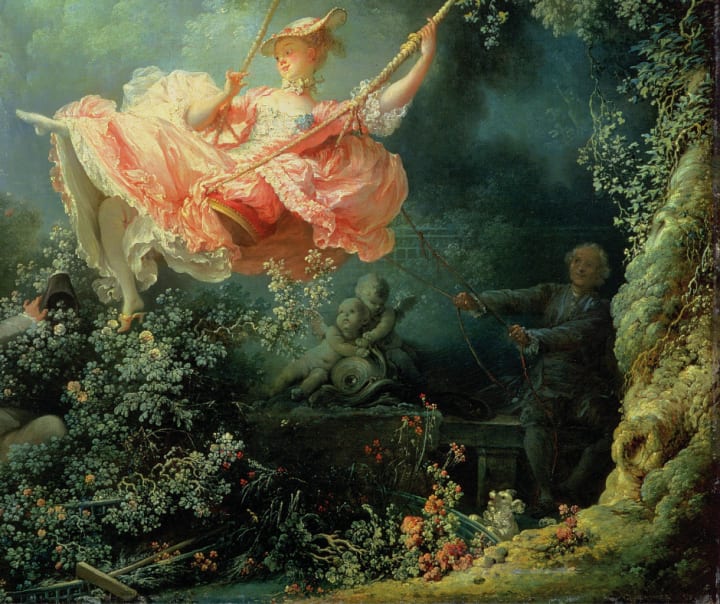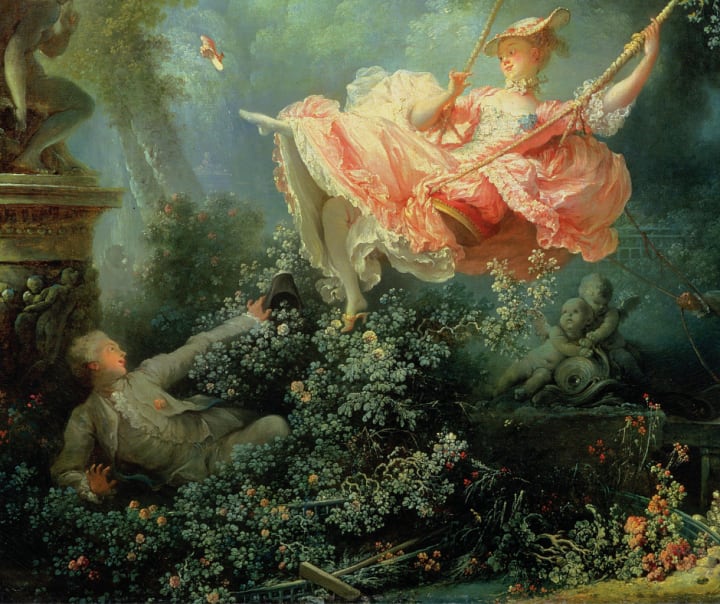
The Swing by Jean-Honoré Fragonard between 1767 and 1768
Every time I gaze upon Jean-Honoré Fragonard's masterpiece, "The Swing," I am captivated by its breathtaking beauty and overwhelmed by a profound sense of love.
However, upon closer examination, the painting reveals a story far more scandalous and intriguing than initially meets the eye. Commissioned as a private artwork, this audacious piece pushed boundaries, forever altering Fragonard's career and establishing itself as a pinnacle of his artistic achievements.
Unveiling the Commission
Originally approached with the commission, Gabriel Francois Doyle, a renowned religious history painter, promptly declined, fearing the impact on his respectable reputation. In his stead, Fragonard enthusiastically took on the challenge, despite being the second choice due to his recent financial struggles with the aristocracy. The identity of the commissioning individual remains unknown, but many speculate it to be Baron de San Julian, the Receiver General of the French clergy.
The Innocence of Appearance
At first glance, "The Swing" exudes innocence and playfulness. It features a woman suspended from a tree in a vibrant pink dress, seated on a plush red velvet swing. Illuminated as if by divine light, she stands out against a backdrop of lush vegetation, suggesting a secluded garden enclosed by a fence.
Delving Deeper
As we delve deeper into the painting, we witness the woman's whimsical flight, barely gripping the ropes as she reaches the zenith of her swing. She playfully kicks up her left leg, revealing her ankle, which held a provocative allure during the time the painting was created.

Observing from below, a man lies hidden within a bush, gazing up at her with a mix of excitement and adoration. While it may initially seem shocking, the true complexity of the narrative is yet to be unveiled.
An Unconventional Love Story
"The Swing" tells an unconventional love story involving a triangle of relationships. The man concealed in the bush is none other than the individual who commissioned the painting, also the lover of the woman swinging.

The older man, likely her husband, gazes at her affectionately, oblivious to the presence of the younger admirer lurking nearby. Fragonard subtly subverted the patron's original request, replacing the bishop with the deceived husband. This ingenious alteration emphasizes the oscillation between the woman's lover and her husband, mirroring the swinging motion.
Female Empowerment and Authority
Notably, the woman depicted in the painting exudes confidence and authority, standing as the true orchestrator of the scene. Physically, she dominates the composition, radiating vitality and charm. Symbolically, she flings her shoe towards a statue of Cupid, accompanied by a gesture reminiscent of secrecy.

The inclusion of the statue, bearing resemblance to one created for Madame de Pompadour, King Louis XV's mistress, adds a layer of intrigue, while the "putti" statues express shock and shame. A barking dog, traditionally a symbol of fidelity, further emphasizes the theme of infidelity and fidelity.
The Private Nature of the Painting
Private commissions like "The Swing" were intended for display in intimate spaces within the homes of affluent individuals, known as cabinets. These paintings allowed patrons and their select friends to revel in art that challenged societal norms, offering a personal and pleasurable diversion. The work garnered such admiration that Nicholas Deloney created a print version in 1792, widening its audience, albeit among the social elite.
Impact on Fragonard's Career
"The Swing" marked a turning point in Fragonard's career, steering him towards private commissions rather than royal patronage. His playful and carefree style found resonance in this new realm of artistry.

Consequently, critical commentary and documentation on his works are relatively scarce, with a comprehensive study of his oeuvre only gaining momentum in recent decades.
Jean-Honoré Fragonard's "The Swing" serves as a masterpiece that transcends its whimsical facade to expose an intricate narrative of love, deception, and female empowerment.
Through its subversive imagery, Fragonard challenged societal conventions while creating a work of undeniable beauty. This painting continues to intrigue and captivate viewers, reminding us that art has the power to transport us beyond the surface, inviting exploration of hidden depths.
In the enchanting realm of "The Swing," Fragonard expertly weaves a tale that will forever leave an indelible mark on the annals of art history.
About the Creator
MD
I am a poet and writer, entwined in passionate embrace with souls of poets, penning love letters to their words.
If you love my poets give a like, leave comments and share them with love. Don't forget to subscribe to my profile.
Thank you!






Comments
There are no comments for this story
Be the first to respond and start the conversation.